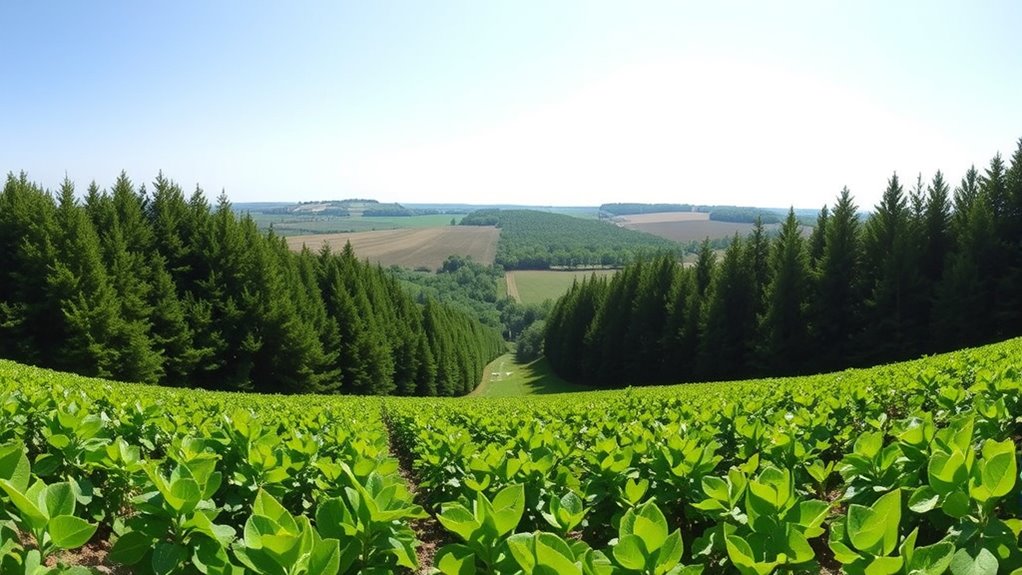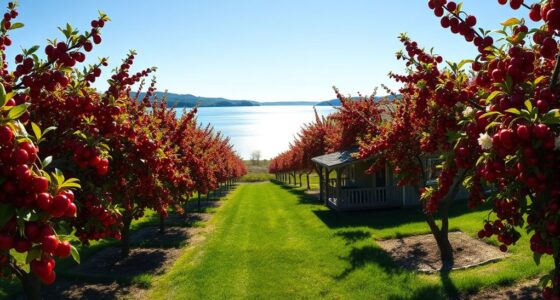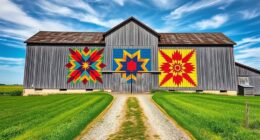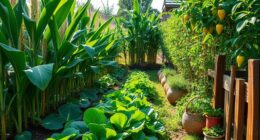Windbreaks and shelterbelts are natural barriers that protect your farm from wind erosion, reduce water loss, and create a stable microclimate for healthy crop growth. By planting trees along field edges, you can prevent soil loss, attract beneficial insects, and improve soil fertility over time. These natural features have saved many farms from degradation and crop failure. Continue exploring to discover how implementing these strategies can transform your land and guarantee long-term productivity.
Key Takeaways
- Windbreaks and shelterbelts reduce soil erosion by acting as natural barriers against strong winds.
- They create microclimates that protect crops from frost, heat, and water loss, enhancing yield stability.
- Shelterbelts attract beneficial insects and birds, naturally controlling pests and reducing chemical use.
- Properly planned windbreaks improve soil fertility through organic matter addition and moisture conservation.
- Natural barriers strengthen land resilience, making farms more sustainable and less vulnerable to climate and wind damage.

When harsh winds threatened farmland, farmers discovered that planting windbreaks and shelterbelts could make all the difference. These natural barriers do more than just block the wind; they play an essential role in protecting the soil from erosion. Without proper protection, strong gusts can strip away the topsoil, leaving fields less fertile and more vulnerable to degradation. By planting trees and shrubs strategically along field edges, you create a shield that reduces wind velocity. This not only helps keep your soil intact but also preserves moisture, which is critical for healthy crops. As a result, soil erosion decreases markedly, enabling your land to remain productive year after year.
Planting windbreaks protects soil from erosion and preserves moisture for healthier, more productive farmland.
Beyond soil conservation, windbreaks and shelterbelts help in microclimate regulation. When you introduce these barriers, they modify local weather conditions around your farm. For example, they can lower wind speeds, which reduces the physical stress on plants and minimizes water loss through evaporation. This creates a more stable environment, allowing crops to grow more uniformly and thrive even in adverse weather. Shelterbelts can also moderate temperature swings, protecting delicate plants from frost in spring and fall, while providing shade during scorching summer days. By controlling these microclimate factors, you make your farmland more resilient to extreme weather patterns, ultimately boosting crop yields and farm sustainability.
Furthermore, planting windbreaks offers several additional benefits. They attract beneficial insects and birds that help manage pests naturally, reducing your need for chemical interventions. The trees and shrubs also add organic matter to the soil when their leaves and branches decompose, enriching it with nutrients. Over time, these natural features can improve soil structure and fertility, making your land more productive in the long run. Plus, shelterbelts can provide habitat for wildlife, fostering biodiversity on your farm.
In essence, implementing windbreaks and shelterbelts is a practical and sustainable strategy. They serve as a frontline defense against the destructive forces of wind, safeguarding your soil and creating a more controlled microclimate. This, in turn, helps you maintain healthier crops, conserve water, and reduce erosion — all essential for resilient, productive farmland. As you plan your landscape, consider the placement, species, and density of your shelterbelts to maximize these benefits. With careful design, you’ll find that these natural barriers don’t just protect your land—they transform it into a more stable, thriving environment. Incorporating effective co-parenting plans and ensuring consistent routines can also contribute to a more stable environment on the farm or property, promoting better management and overall sustainability.
Frequently Asked Questions
How Do Windbreaks Impact Local Wildlife Habitats?
Windbreaks positively impact local wildlife habitats by providing shelter for birds and insects. You’ll notice more bird habitats as they nest and rest within the trees and shrubs, which also help maintain healthy insect populations. These natural barriers protect animals from harsh weather and predators, creating a balanced ecosystem. By planting windbreaks, you support diverse wildlife, enhancing the farm’s overall environment and contributing to ecological stability.
What Are the Cost Benefits of Planting Shelterbelts?
Planting shelterbelts offers significant economic savings by reducing wind erosion and protecting crops, which boosts crop yield. You’ll notice fewer expenses on soil conservation and less need for artificial windbreaks or pest control. Shelterbelts also create microclimates that improve crop growth. Over time, these benefits lead to increased farm profitability, making the initial investment in planting a worthwhile strategy for long-term financial stability and improved productivity.
How Do Climate Changes Affect Windbreak Effectiveness?
Like a shield in a storm, climate change tests windbreaks’ resilience. You might find they become less effective as shifts in temperature, wind patterns, and precipitation alter their growth. Rising temperatures can stunt trees or cause stress, reducing their barrier against wind erosion. To maintain climate resilience, you need adaptable shelterbelts, ensuring they continue to protect farms from wind erosion and preserve soil health amid changing conditions.
What Are the Best Tree Species for Shelterbelts?
You should choose native species like Eastern red cedar, black cherry, or dogwood for shelterbelts, as they adapt well to your local climate. Use proper planting techniques, such as staggered rows and adequate spacing, to guarantee healthy growth and wind protection. Native trees provide resilience against pests and weather changes, making your shelterbelt more effective. These choices help create a durable, sustainable windbreak that benefits your farm long-term.
Can Shelterbelts Be Integrated With Modern Farming Practices?
Think of shelterbelts as the steady heartbeat of modern farming—integrating them is like adding a essential rhythm to agricultural innovation. You can plant them strategically for soil conservation, providing wind protection while boosting biodiversity. Incorporating shelterbelts into your farm design enhances sustainability without sacrificing productivity. By blending traditional shelterbelt principles with cutting-edge practices, you create a resilient farm that thrives amid changing climate conditions and fosters long-term health for your land.
Conclusion
You see, while storms can devastate crops and erode soil, windbreaks and shelterbelts stand as quiet protectors, anchoring your farm against nature’s fury. They’re not just rows of trees; they’re shields that save your livelihood. Without them, you face the relentless power of wind and dust. Yet, with these natural barriers, you gain peace of mind and resilience. In a way, they’re the silent heroes safeguarding your land when you need it most.










